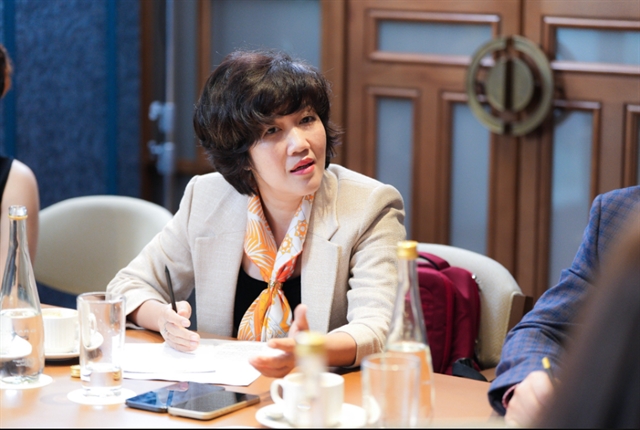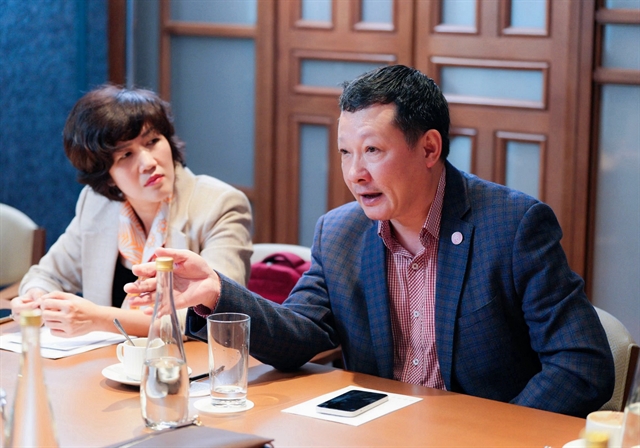 Society
Society

HÀ NỘI — Multiple Myeloma (MM), a relatively uncommon blood cancer that affects plasma cells, which are responsible for antibody production in the body, poses a significant health challenge.
According to data from the International Agency for Research on Cancer (IARC), there will be approximately 187,952 new cases of MM worldwide in 2022. In Việt Nam, the reported number of MM cases is 607 new cases every year, with a high mortality rate.
Early-stage symptoms of this disease include fatigue, loss of appetite, weight loss and mild bone and joint pain. While MM remains an incurable condition, advancements in medical research have introduced various treatment methods that greatly contribute to improving patients' overall well-being.
Experts from leading hospitals in Việt Nam shared the latest about advancements in treatment of MM.
The signs and symptoms of MM cancer
Đỗ Huyền Nga, Head of the Hematology Department at Việt Nam National Cancer Hospital
 |
MM is not a commonly occurring cancer. However, it is a chronic disease requiring long-term treatment. Consequently, the progression of MM accumulates over time. This disease primarily affects individuals aged 60 years and older.
Patients present with a diverse set of symptoms. For instance, at the hematology institute, patients often seek medical attention when they experience signs of blood formula disorders. At the Việt Nam National Cancer Hospital, most cases involve bone damage, such as pathological fractures and spinal cord compression. In contrast, at Chợ Rẫy Hospital, patients typically present with kidney failure.
According to international records, the average age of infection is 68 years old. However, in Việt Nam, based on clinical observations, it appears that the disease affects individuals at a younger age compared to the global average. While worldwide cases of this disease are rarely seen in individuals under the age of 30, we still encounter patients under 30 years old in Việt Nam.
The exact cause of the disease remains unclear. However, early indications often manifest through elevated levels of monoclonal globulin. Instead of seeking specialised care, patients often turn to a family doctor or a general practitioner.
In other countries, when elevated globulin levels are detected in the blood, doctors typically order additional tests as a precautionary measure. However, in Việt Nam, early detection is not common and patients often present themselves at the hospital already exhibiting typical symptoms of MM.
Hoàng Thị Thúy Hà, Deputy Head of Hematology Department, Chợ Rẫy Hospital
 |
While MM treatment has not yet reached the level of global advancements, significant progress has been made in recent years with the adoption of many effective treatment methods. The recommended drug regimens for newly diagnosed or relapsed stages have successfully addressed most treatment needs.
Dr. Vũ Đức Bình, Deputy Director of the National Institute of Hematology and Blood Transfusion
 |
As the specialty hospital for treating MM, the National Institute of Hematology and Blood Transfusion receives a large number of patients. Many patients who come to the hospital have treatment-resistant relapses and are transferred from lower-level facilities when their treatment capacity is exceeded. Additionally, some patients present complications such as kidney failure, bone pain and joint pain, but do not get better with treatment, then are discovered to have multiple myeloma. Some other patients were diagnosed with MM after undergoing surgery for bone-related issues.
However, the recognition of the disease can be based on clinical signs such as bone pain at various levels, anemia caused by increased cell proliferation in the bone marrow and kidney failure. Doctors then proceed with further diagnostic tests.
The cost of treatment poses a burden for patients, regardless of whether the disease is detected early or late.
The difficulties in treating MM patients
Hoàng Thị Thúy Hà:
Treating MM patients comes with several challenges. Firstly, it is a chronic disease that requires lifelong treatment. Patients often undergo intensive treatment initially, followed by maintenance treatment. If the condition worsens during first treatments, they may require another round of intensive treatment and this treatment cycle must be continued.
One major difficulty faced by patients is the financial burden. The cost of drugs can be quite high, on average, the monthly cost for maintenance treatment is around VNĐ4 to VNĐ5 million, which is the minimum expense.
During the initial treatment phase of maintenance treatment, patients typically need to visit the hospital twice a week for injections, usually not every month. If we have access to the necessary medications, we can alleviate this burden on patients.
While patients residing in urban areas may have relatively fewer challenges, those from provinces face significant difficulties. Many patients have to rent accommodation near the hospital to undergo their treatment.
Additionally, prolonged treatment can lead to drug-related side effects that further complicate the patient's condition.
Advanced medical methods available for treating MM
Dr. Vũ Đức Bình:
When it comes to treating chronic diseases, researchers worldwide are continuously exploring new treatment approaches. These treatments can be administered orally, intravenously, or subcutaneously, each method having its advantages and disadvantages.
Oral administration (the triple oral treatment regimen) offers several benefits for patients as it allows for outpatient treatment. Patients can take the medication home and undergo regular follow-up tests. However, not all patients can use the oral route. Those with gastrointestinal conditions, such as stomach issues or reflux, may need to receive injections instead.
Depending on the patient's condition and the flexibility of the medical staff, a suitable treatment regimen is determined for each individual, considering both the patient's financial situation and the hospital's resources.
Đỗ Huyền Nga:
This oral triple regimen is indicated for patients with multi-refractory MM. It can also be a suitable option for elderly patients who cannot frequently visit the hospital.
Currently, these medications are not covered by insurance, making access even more challenging. However, when discussing advantages, oral treatment improves patient compliance with the regimen and reduces the rate of treatment discontinuation.
In terms of health economics, studies have evaluated that the cost of medication is equivalent whether it is administered through injections, intravenously, or orally. However, the injection route incurs additional expenses such as hospitalisation, the need for a hospital bed and medical staff, making it slightly costlier.
In terms of effectiveness, both regimens yield comparable results. Therefore, opting for the injection regimen combined with the oral route tends to be preferred since it is covered by health insurance.
Facilitating people's access to upcoming treatments
Hoàng Thị Thúy Hà:
Regarding convenience, oral medications offer much greater convenience. Considering the recent COVID-19 pandemic, it has been challenging for patients to visit hospitals so patients who can take their medication at home experience significant benefits.
Moreover, elderly patients often have concerns about going to the hospital. Some patients have only recently resumed their treatment after the COVID-19 pandemic.
This content is endorsed by the Vietnam Association of Hematology and Blood Transfusion. — VNS




